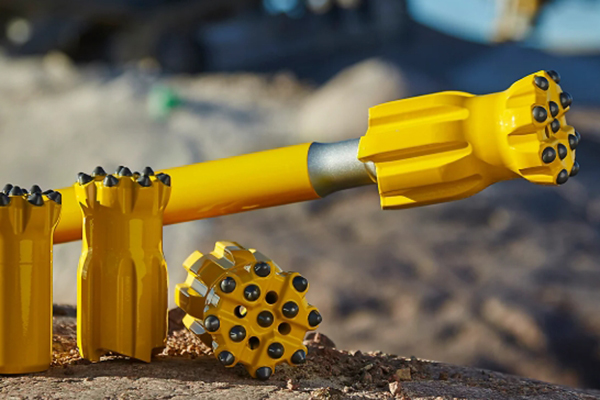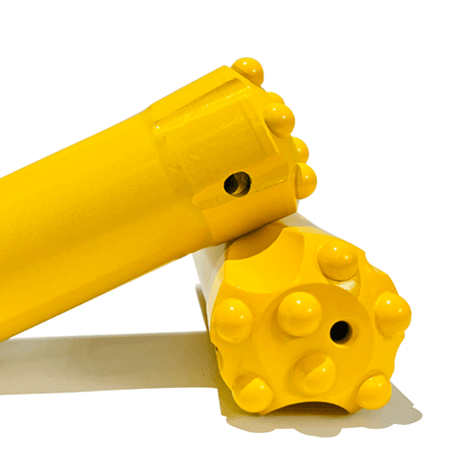Hello, I’m Allen, and for over two decades, I’ve been at the heart of manufacturing self-drilling anchor systems and drilling tools. From my factory in China, we’ve shipped millions of high-quality tools to construction sites, mines, and tunnels across the globe, from the USA to Australia. I’ve spoken with hundreds of procurement officers like Mark Davis—decisive, knowledgeable business owners who need reliable tools at a competitive price. They know their business, but the deep technical side of a drill bit? That’s where I can help.
This article is for you, Mark, and for everyone who needs to break through the toughest materials on earth. Drilling into hard rock is not just about having a powerful drill. It’s about the synergy between the machine, the tool, and the technique. Choosing the wrong drill bit can lead to costly delays, broken equipment, and project failures. In this guide, I’ll share my firsthand experience to help you understand the nuances of rock drilling, select the perfect rock drill bit, and ensure your projects run smoothly and efficiently. We will cover everything from the right type of hammer drill to the specific bit you need for granite.
Why is Drilling into Hard Rock Such a Challenge?
Drilling into soil or soft stone is one thing. But when you hit dense igneous rock like granite, the game changes completely. The primary challenge is the material’s immense compressive strength and abrasive nature. Imagine trying to push a pin into a steel plate—that’s the level of resistance we’re talking about, but on a much larger scale.
A standard drill simply spins. It relies on a sharp cutting edge to shave away material. This works for wood or metal, but against hard rock, that sharp edge will dull in seconds. The rock doesn’t get cut; it gets worn down. This process generates an incredible amount of friction and heat, which can destroy a lesser drill bit very quickly. The task is not to cut the rock, but to pulverize and break it into small fragments that can be flushed out of the hole. This requires a combination of immense impact force and rotation, something a standard drill just can’t provide.
What Type of Drill Should I Use for Hard Rock?
The drill you use is just as important as the bit. Using the wrong machine will, at best, be ineffective and, at worst, damage the tool and potentially injure the operator. For drilling into rock, you have two primary options that are far superior to a standard cordless drill.
- Hammer Drill: A hammer drill is a step up from a regular drill. It combines rotation with a rapid, short-distance hammering action. Think of it as a drill that is also a very fast, light hammer. This impact helps to chip away at brittle materials like brick, mortar, and softer stone. For light-duty masonry work or drilling a shallow hole in less dense rock, a hammer drill can be sufficient. However, for serious hard rock drilling, it’s often underpowered.
- Rotary Hammer Drill (aka Rotary Drill): This is the true workhorse for hard rock. A rotary hammer uses a more complex and powerful piston mechanism to generate a much stronger hammering blow. This mechanism allows it to pulverize hard materials like concrete and dense rock with ease. They are bigger, heavier, and use a special chuck system (like SDS-Plus or SDS Max) designed to hold specialized rock drill bits and handle the intense force. If you need to drill multiple deep holes or work with materials like granite, a rotary hammer drill is not just a recommendation—it’s a necessity. The hammering action does the heavy work of crushing the rock, while the rotation clears the debris from the hole.

How Do I Choose the Best Rock Drill Bit for the Job?
Once you have the right drill, the drill bit is your next critical choice. A drill bit is not a one-size-fits-all tool. The right one will depend on the rock‘s hardness, the required hole diameter, and the depth you need to achieve. Let’s break it down.
The most important component of a rock drill bit is its tip. For hard rock, you need a tip made from an extremely hard material. Tungsten carbide is the industry standard. It’s a compound that is incredibly tough and resistant to heat and abrasion. The carbide inserts are brazed onto the steel body of the drill bit, creating a powerful cutting head that can withstand the punishment of hammering into rock.
Here’s a simple table to guide your selection:
| Drill Bit Type | Best Use | Material Tip | Key Feature |
|---|---|---|---|
| Masonry Bit | Brick, Block, Soft Stone | Tungsten Carbide | Flatter tip, designed for chipping. |
| Rock Carbide Bit | Concrete, Hard Rock | Tungsten Carbide | Chisel-shaped or multi-cutter head. |
| Diamond Core Drill Bit | Granite, Reinforced Concrete | Diamond Segments | Hollow core, grinds instead of chips. |
| Self-Drilling Anchor Bit | Unstable Ground, Rock | Tungsten Carbide/Steel | Drills and grouts simultaneously. |
For many of our clients, the choice comes down to our comprehensive range of Rock Drilling Bits. They come in a variety of designs and size options, ensuring there’s a perfect tool for any type of rock or drilling task. A procurement officer needs a supplier who offers this variety, because one project might require drilling into stone walls, while the next involves deep foundation work in solid granite.
Can You Recommend a Good Drill Bit for Granite and Other Hard Stones?
Absolutely. When you’re dealing with very hard rock like granite, a standard carbide drill bit may struggle or wear out quickly. This is where a diamond core drill becomes invaluable. Unlike other bits that chip and fracture the material, a diamond bit works by grinding. The edge of the hollow bit is coated with fine diamond particles, the hardest known material. As the drill spins, these abrasive particles grind a precise, smooth hole into the rock.
The process is slower than using a rotary hammer with a carbide bit, but it’s far more controlled and is the only way to create a large diameter hole in the hardest materials. For smaller hole sizes or when you need to drill many holes quickly for something like installing a split rock friction anchor, a high-quality, multi-cutter head carbide rock drill bit is still the more efficient choice. A good drill bit for granite will have premium-grade carbide inserts and a robust steel body to prevent the drill shaft itself from breaking under the high torque and impact.

What’s the Real Difference Between a Masonry Bit and a True Rock Drill Bit?
This is a common point of confusion that can lead to a lot of frustration. A masonry bit and a rock drill bit might look similar, but they are engineered for different levels of abuse. A masonry drill bit is designed to drill holes in relatively soft and abrasive materials like brick, mortar, or cement blocks. Its carbide tip is typically flatter and designed for chipping.
A true rock drill bit, on the other hand, is built for a much tougher job.
- Head Design: It often features a more aggressive, pointed, or multi-cutter head (with four cutting edges). This design helps to focus the impact force, allowing it to penetrate dense rock more effectively and creating a more round and precise hole.
- Carbide Grade: The quality of the tungsten carbide is generally higher in a rock drill bit. This ensures it stays sharper for longer and resists fracturing under the intense, repeated impacts from a rotary hammer drill.
- Body and Flute Design: The steel body of a rock drill bit is often made from a higher-grade alloy, and the flutes (the spiral grooves) are designed for maximum debris removal to prevent the hole from clogging, which can cause the bit to bind and break.
Using a masonry bit on hard rock is a false economy. It will wear out incredibly fast, drill much slower, and you’ll likely break the bit or even damage your drill. That’s why investing in the proper tool for the job is always the better decision.
How Does the Type of Rock Influence My Choice of Drill and Bit?
Not all rock is created equal. Understanding the basic geology of your worksite can save you a tremendous amount of time and money. A geologist could give you a thousand-page report, but for our purposes, we can simplify it.
- Sedimentary Rock (e.g., Sandstone, Limestone): This type of rock is relatively soft and easy to drill. A powerful hammer drill or a smaller rotary hammer with a standard carbide rock drill bit will typically work very well. The main concern here is the abrasive nature of sandstone, which can still wear down a cheap bit.
- Metamorphic Rock (e.g., Marble, Slate): Hardness can vary greatly here. Slate can be brittle and easy to split, while marble can be denser. You’ll likely need a rotary hammer for these. The key is to use a sharp bit to avoid causing a large fracture on the surface.
- Igneous Rock (e.g., Granite, Basalt): This is the hard rock category. It’s dense, non-porous, and extremely hard. This is non-negotiable territory for a powerful rotary hammer drill (SDS Max is a good choice) paired with a premium rock drill bit. For large diameter holes, a diamond core drill is the only practical solution. You are not just drilling; you are fighting a tough opponent, and you need the best tool.
What is the Correct Rotary Speed and Feed Pressure to Use?
Technique is everything. You can have the best drill and bit in the world, but if you use them incorrectly, you’ll get poor results. When drilling into hard rock, the mantra is: slow speed, high pressure.
Trying to drill too fast is a rookie mistake. High speed generates excessive heat, which is the number one enemy of a carbide tip. The heat can soften the carbide, causing it to dull almost instantly. Instead, set your rotary hammer to a lower speed and let the machine’s hammering action do the work. Your job is to apply firm, steady forward pressure (the feed) to keep the bit engaged with the rock. If you see dust, you’re doing it right. If you see sparks or the bit starts to glow, stop immediately! Let the bit cool down. For deep holes, it’s also a good practice to periodically pull the drill bit out of the hole to help clear out debris. This simple step can prevent the bit from getting stuck and improve your drilling efficiency.
What Are Some Common Mistakes to Avoid When Drilling Hard Rock?
Over my years in the business, I’ve seen the same costly mistakes made over and over. Avoiding them will give you a much better experience.
- Using the Wrong Drill: Trying to use a standard drill or a light-duty hammer drill on hard rock is the most common error. It just won’t work. You need the power of a rotary hammer.
- Buying Cheap Bits: It’s tempting to save a few dollars on a drill bit, but it’s a huge mistake. A cheap bit will wear out faster, requiring you to buy more in the long run. Worse, it could break in the hole, creating a much bigger problem. A quality bit is an investment in productivity.
- Overheating the Bit: As I mentioned, going too fast generates heat. If your drill bit turns blue, you’ve ruined its temper. Let it cool periodically, either by air-cooling or dipping it in water (though be careful, as a rapid temperature change can also cause a fracture).
- Not Clearing the Hole: Failing to remove the pulverized rock from the hole increases friction and heat. It forces the drill to work harder and can cause the bit to bind. Let the flutes do their job, and periodically retract the drill.
Beyond the Drill Bit: What Other Tools Do I Need?
A successful rock drilling operation, especially in geotechnical engineering or tunneling, involves more than just a drill and a bit. It’s a system. The drill bit is the tip of the spear, but it needs a strong shaft. That’s where components like drill rods and adapters come in.
For example, when creating a deep anchor point, you’ll need to connect the drill bit to the drill machine with a series of rods. This requires high-quality shank adapters that can transfer the rotational and impact energy without failing. These adapters must be precision-machined to ensure a tight, secure fit. I’d say that after the drill bit, the quality of your drill rods and couplers is the next most critical factor for deep drill applications. For specialized jobs, you might even be using a Self-drilling Hollow Anchor, which acts as the drill rod and the final anchor bolt all in one. It’s an amazing technology that saves a huge amount of time.
How Can I Verify the Quality of My Drilling Tools?
This is a critical concern for any procurement officer like Mark. When you’re buying tools from overseas, you need to trust your supplier. Here are a few things I advise all my clients to look for:
- Material Specifications: Ask for them. A reputable factory will be able to tell you the exact grade of steel and tungsten carbide they use. If they are evasive, that’s a red flag.
- Certifications: Look for ISO 9001 certification. This shows that the factory has a quality management system in place. Don’t be afraid to ask for a copy of the certificate. I’ve heard stories on a machinist forum about suppliers faking these, so it’s wise to be diligent. Some clients complain that on a supplier’s website,
javascript is disabled, making it impossible todownloada PDF of the certificate. A professional supplier ensures their website works on anybrowser before proceedingwith business. - Factory Inspection: If you’re placing a large order, a factory visit or a third-party inspection is the best way to verify quality. As a factory owner, I welcome these inspections. It shows the customer is serious, and it gives us a chance to demonstrate our capabilities.
- Supplier Expertise: Does your sales representative just want to make a sale, or do they understand the tool? A good supplier should be a partner who can provide technical advice and help you choose the right product. That’s the kind of relationship we strive for. We want to be more than just a name on an invoice; we want to be a part of your success.
Drilling into hard rock is a demanding task, but with the right knowledge, the right drill, and the right drill bit, it becomes a manageable, efficient process. It’s about a systematic approach, not brute force.
Key Takeaways to Remember
- Match the Drill to the Job: For hard rock, a powerful rotary hammer drill is essential. Don’t try to get by with a standard drill or light-duty hammer drill.
- The Bit is Critical: Invest in a high-quality rock drill bit with a premium tungsten carbide or diamond tip. It will save you time, money, and frustration.
- Technique Matters: Use low drill speeds and high, steady pressure. Keep the bit cool and the hole clear of debris to maximize performance and lifespan.
- Know Your Rock: Understanding the type of rock you are drilling into will help you select the most effective drill and bit combination.
- Verify Your Supplier: Work with a reputable factory that provides transparent documentation, holds international certifications, and offers expert guidance. Your supply chain is the foundation of your business.
Post time: Jul-05-2025















